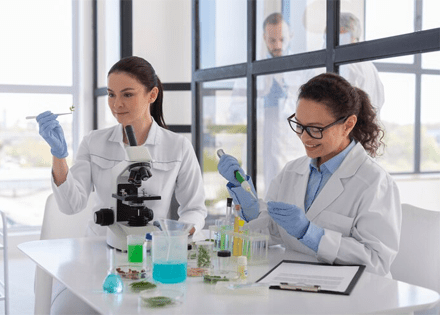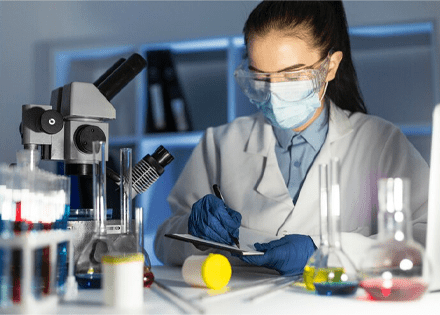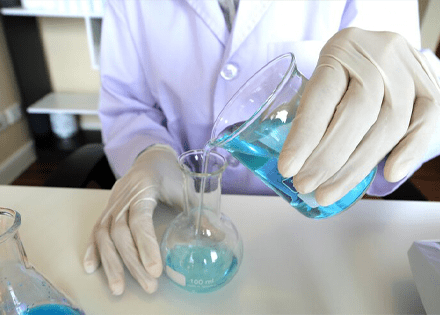NABL Accredated Commercial Laboratory Facility
Home / NABL Accredated Commercial Laboratory Facility
NABL Certified Lab
Accredited commercial lab providing accurate results with NABL certification OR Commercial laboratory with NABL accreditation ensuring accurate results
Commercial Laboratory Facility (As Per NABL, ISO 17025:2017, NAAQ, FSSAI)
SAI BIOCARE PVT LTD has the required background and technical ability in the field of Environmental Pollution Monitoring & Analysis. Its “Department of Laboratory” is been ISO 17025:2017 certified which been adhered to guidelines of National accreditation Board of Laboratories (NABL). We encompass a complete range of solutions in the field of Environmental Quality control and Quality Management. The laboratory personnel are member of Quality Council of India and strictly follows quality in performance. The department of testing laboratory strictly functions as per NABL, ISO, NAAQ, FSSAI guidelines and procedures of testing.



SAI BIOCARE PVT LTD (Department of Testing) is known for below mentioned services:
- Wastewater quality content(ions) analysis.
- Potable/borewell/Drinking water Quality analysis.
- Swimming pool & farming type required water testing.
- Indoor Air quality analysis in hospitals, offices & industries, safe working places.
- Field monitoring, sampling, and testing on site.
- Microbial contamination in water food testing.
- Noise, Soil, Illumination Testing.
- Contract research project work for product development Technology transfer on research and development.
- Other technology development and research facility as and when required.
SAI BIOCARE PVT LTD has specialized experience in facilities in determining quality horizons of water and wastewater, materials, chemicals, food products, Ambient Air Quality Monitoring,
Excellent : The Laboratory is having a facility with high ended instruments with a team of highly qualified technocrats and experts exclusively in the field of Environment and Microbiology including some specialized testing services.
Our core strength is supported with team of highly qualifies technocrats and experienced technical professionals in the field of environment, chemical testing, microbiology and consultancy.
-
Water quality testing
& analysis -
Field Monitoring, sampling
& air quality analysis -
Noise, Soil, Illumination
Monitoring -
Open for contract research/Project work
Water quality analysis is referred to Physical, Chemical Biological characteristics of water.
- Physical Characteristic: temperature, colour, taste, odour & Turbidity etc.
- Chemical Characteristics: A chemical property is a characteristic of a particular substance that can be observed in a chemical reaction. Eg; BOD, COD, DO, pH value
- Biological characteristics: Biological indicators of water quality include algae and phytoplankton.
Water Quality Standards :
The water quality standards used for judging the quality of water derived after the treatment process. An evaluation of health risks associated with drinking water is necessary and timely. There are three basic objectives of water treatment, namely,
- production of water that is safe for human consumption.
- production of water that is appealing to the customer.
- production of water treatment facilities, which can be constructed and operated at a reasonable cost. For total hardness and alkalinity, the standards specify minimum values to be respected when water undergoes softening.
Types of Water the Lab is analyzing/monitoring :
Ground water, Industrial water, Surface water (As Per IS: 2296), Drinking water (as per IS:10500), Swimming pool water and others(semi-liquid sludge, Used Oil, Soil testing, Food testing, swab testing) etc.
Ambient air pollutants and fugitive dust emissions (as per National Ambient Quality Standards)
Air Quality Standards :
To improve air quality in areas where the current quality is unacceptable and to prevent deterioration in areas where the air is relatively free of contamination. To accomplish this task, OAQPS establishes the National Ambient Air Quality Standard (NAAQS) for each of the criteria pollutants.
Criteria Pollutants :
A few air pollutants, called criteria air pollutants, are common . These pollutants can injure health, harm the environment and cause property damage. The current criteria pollutants are: PM2.5, PM 10 , CO, SO 2 , NO 2 ,Lead, Nickel etc.
Scopes of Field Monitoring are :
- Ambient Air/Work Zone
- Source Emission Monitoring
- Ambient Noise
- Ambient Illumination
- Dust Monitoring
1. Ambient Air / Work Zone Air Monitoring:
Air Quality Monitoring is the systematic, long-term assessment of pollutant levels by measuring the quantity and types of certain pollutants in the surrounding, outdoor air we breathe. The data, over a long term, allows us to tease out patterns that help support air pollution control policy.
Examples of Ambient Air Parameters are: SO2 , NO2, PM10, PM2.5, CO, CO2, Suspended Particulate Matter etc.
2. Source Emission Monitoring:
Source emissions monitoring involves taking direct measurements of an emission source, usually at an industrial or manufacturing facility. Often the impetus for source emission sampling is a requirement for annual monitoring in the site environmental license.
Hence, the purpose is often to demonstrate compliance of emissions with the legislative requirements and the environmental performance commitments of a company. Other circumstances where stack testing is required include development of new processes and products, and testing to allow optimization of existing processes.
For example, stack emission testing data can provide an important indication of the efficiency of a combustion process, or a particular production, as this type of testing allows the compounds that are being emitted as a waste product via the stack to be quantified.
Examples of the compounds and substances we are experienced in testing include the following: SO2, NO2, CO2, CO, Particulate Matters etc
- Measurement of Ambient Noise:
It is the measurement of Noise in an outdoor environment caused by transport (e.g. motor vehicles, aircraft, and trains), industry (e.g. machines) and recreational activities (e.g. music). The laws and limits governing environmental noise monitoring differ from country to country.
It is able to analyze the surrounding ambient sound in the audible frequency spectrum for the human ear, showing collected data in dBA.(decibel)
The most common instruments used for measuring noise are the sound level meter (SLM), the integrating sound level meter (ISLM), and the noise dosimeter.
- Illumination Monitoring:
The quantity of light that illuminates a surface; measured in lux. One lux (Latin for “light”) is the amount of illumination provided when one lumen is evenly distributed over an area of one square metre.
The monitoring of Lux (Luminous Intensity) for various sites like office, Factory, Hotel, Store, Hospital, School etc.
- Dust Monitoring:
Dust monitoring is one aspect of air quality that industrial hygienist use to determine the amount of dust particles present in the workplace, cities or communities over a given period of time.
Provide laboratory facilities to any kind of research activity. Small and medium level of research work is always welcome. We are doing minimum of 7 major projects of varying areas which imparts expertise to our professionals too. We are excellent at contract research and known for our time bound completion of project with almost nil error.
We provide hands on training on STP and ETP operation, Quality analysis of Water , Microbial analysis and final year projects too.
We also pledge to nurture the young talents of the organization to upgrade their technical skill with contemplations, seminars, workshops and training.






